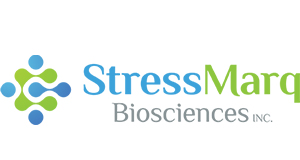Alpha Synuclein N-Terminal Acetylated Monomers (Type 1)
Human Recombinant N-Terminal Acetylated Alpha Synuclein Monomers (Type 1)
Artikelnummer
STRSPR-331E
Verpackungseinheit
100 µg x5
Hersteller
Stressmarq Biosciences
Verfügbarkeit:
wird geladen...
Preis wird geladen...
Target: Alpha Synuclein N-Terminal Acetylated
Nature: Recombinant
Swiss-Prot: P37840
Biological Activity: Seeds aggregation of N-acetylated alpha synuclein monomer (SPR-331) in thioflavin T assay
Expression System: E. coli
Protein Length: Full Length
Purification: Ion-exchange Purified
Purity: >95%
Storage Buffer: PBS pH 7.4
Protein Size: ~14.46kDa
Conjugate: No Tag
Cellular Localization: Cytoplasm / Membrane / Nucleus
Scientific Background: Alpha-Synuclein (SNCA) is expressed predominantly in the brain, where it is concentrated in presynaptic nerve terminals (1). Alpha-synuclein is highly expressed in the mitochondria of the olfactory bulb, hippocampus, striatum and thalamus (2). Functionally, it has been shown to significantly interact with tubulin (3), and may serve as a potential microtubule-associated protein. It has also been found to be essential for normal development of the cognitive functions; inactivation may lead to impaired spatial learning and working memory (4). SNCA fibrillar aggregates represent the major non A-beta component of Alzheimers disease amyloid plaque, and a major component of Lewy body inclusions, and Parkinson's disease. Parkinson's disease (PD) is a common neurodegenerative disorder characterized by the progressive accumulation in selected neurons of protein inclusions containing alpha-synuclein and ubiquitin (5, 6). Alpha synuclein purified from both normal and pathological brain tissue is N-acetylated (7) and this post-translational modification affects affect alpha-synuclein stability and toxicity (8).
References: 1. “Genetics Home Reference: SNCA”. US National Library of Medicine. (2013).2. Zhang L., et al. (2008) Brain Res. 1244: 40-52.3. Alim M.A., et al. (2002) J Biol Chem. 277(3): 2112-2117.4. Kokhan V.S., Afanasyeva M.A., Van'kin G. (2012) Behav. Brain. Res. 231(1): 226-230.5. Spillantini M.G., et al. (1997) Nature. 388(6645): 839-840.6. Mezey E., et al. (1998) Nat Med. 4(7): 755-757.7. Anderson, J.P. et al. (2006) J Biol Chem. 2006;281:29739–29752.8. Vinueza-Gavilanes, R. et al. (2020) Neurobiol Dis. 137, 2020, Article 104783
Field of Use: Not for use in humans. Not for use in diagnostics or therapeutics. For research use only.
Nature: Recombinant
Swiss-Prot: P37840
Biological Activity: Seeds aggregation of N-acetylated alpha synuclein monomer (SPR-331) in thioflavin T assay
Expression System: E. coli
Protein Length: Full Length
Purification: Ion-exchange Purified
Purity: >95%
Storage Buffer: PBS pH 7.4
Protein Size: ~14.46kDa
Conjugate: No Tag
Cellular Localization: Cytoplasm / Membrane / Nucleus
Scientific Background: Alpha-Synuclein (SNCA) is expressed predominantly in the brain, where it is concentrated in presynaptic nerve terminals (1). Alpha-synuclein is highly expressed in the mitochondria of the olfactory bulb, hippocampus, striatum and thalamus (2). Functionally, it has been shown to significantly interact with tubulin (3), and may serve as a potential microtubule-associated protein. It has also been found to be essential for normal development of the cognitive functions; inactivation may lead to impaired spatial learning and working memory (4). SNCA fibrillar aggregates represent the major non A-beta component of Alzheimers disease amyloid plaque, and a major component of Lewy body inclusions, and Parkinson's disease. Parkinson's disease (PD) is a common neurodegenerative disorder characterized by the progressive accumulation in selected neurons of protein inclusions containing alpha-synuclein and ubiquitin (5, 6). Alpha synuclein purified from both normal and pathological brain tissue is N-acetylated (7) and this post-translational modification affects affect alpha-synuclein stability and toxicity (8).
References: 1. “Genetics Home Reference: SNCA”. US National Library of Medicine. (2013).2. Zhang L., et al. (2008) Brain Res. 1244: 40-52.3. Alim M.A., et al. (2002) J Biol Chem. 277(3): 2112-2117.4. Kokhan V.S., Afanasyeva M.A., Van'kin G. (2012) Behav. Brain. Res. 231(1): 226-230.5. Spillantini M.G., et al. (1997) Nature. 388(6645): 839-840.6. Mezey E., et al. (1998) Nat Med. 4(7): 755-757.7. Anderson, J.P. et al. (2006) J Biol Chem. 2006;281:29739–29752.8. Vinueza-Gavilanes, R. et al. (2020) Neurobiol Dis. 137, 2020, Article 104783
Field of Use: Not for use in humans. Not for use in diagnostics or therapeutics. For research use only.
| Artikelnummer | STRSPR-331E |
|---|---|
| Hersteller | Stressmarq Biosciences |
| Hersteller Artikelnummer | SPR-331E |
| Verpackungseinheit | 100 µg x5 |
| Mengeneinheit | PAK |
| Reaktivität | Human |
| Methode | Western Blotting, In Vivo Assay, SDS-PAGE |
| Human Gene ID | 6622 |
| Produktinformation (PDF) |
|
| MSDS (PDF) | Download |

 English
English










